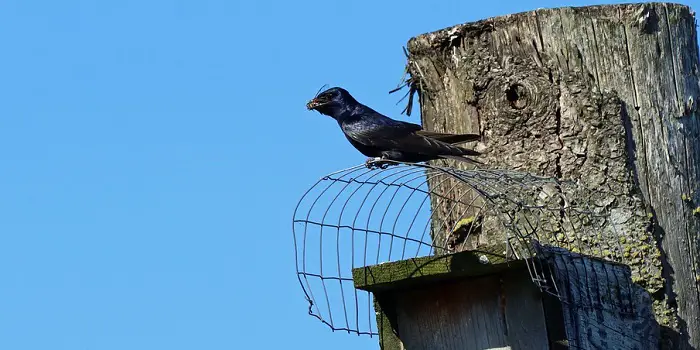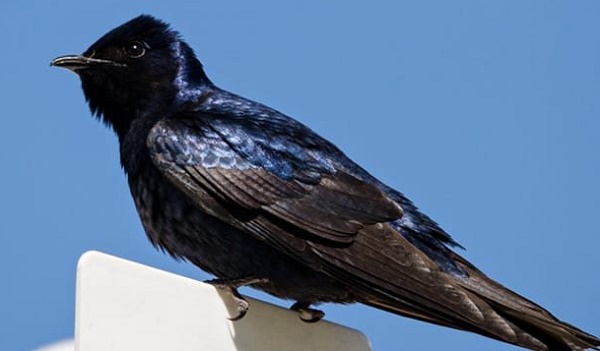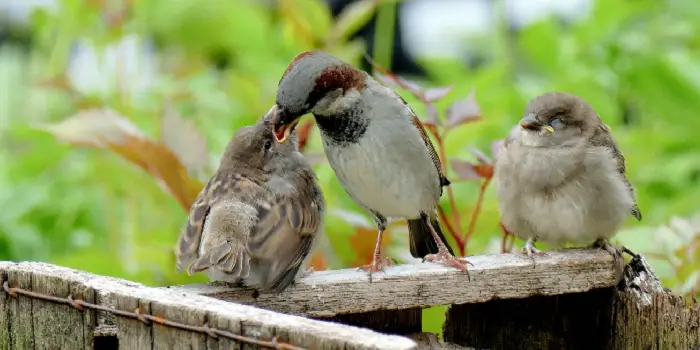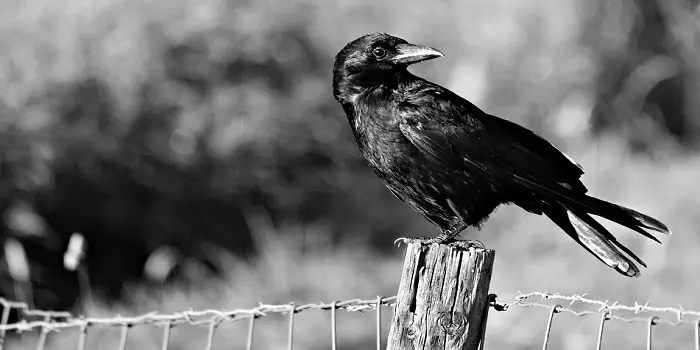
The purple martin is a large swallow of the genus Progne subis.
During the spring season, they migrate to North America for breeding and nesting purposes.
Despite their name, these birds are not purple.
They look bluish in color, but due to the refraction of light, it looks purple to your eyes.
Depending on the light and angle, you may also see the color of these birds as navy blue, bright blue, deep purple, or even green.
Typically, they fly in groups making a lot of noise and disturbing your peace.
But it’s a treat to watch them fly, forming patterns in the sky with good speed and agility.
They are great at performing aerial acrobatics and can fly at a maximum speed of 40 miles per hour while chasing their prey.
How to Get Rid of Purple Martin Birds?
Martins are beautiful. Also, they are beneficial in many ways.
Many Americans therefore, love to attract them by offering houses for them in their yard.
Mostly they try to find their homes in natural habitat, but some may find their shelter in your homes, barns, porch, etc.
If you don’t like purple martins nesting near your home, you can follow the simple humane steps below to keep them at bay.
1- Scrutinize the nesting area
Check out for any nests in your garages, light fittings, trees, etc.
If the young purple martins or eggs do not occupy the nest, remove them without hesitation.
After removing it, please take note of the place where it nested because they tend to come back to that place and try to build their nest again.
If they are present in it, don’t disturb it.
Due to its dwindling population, they are given protection, and you cannot harm them forcefully to make them go away.
2- Cover the nesting area with a mesh
Using a wire mesh (De-Bird Heavy Duty Bird Netting) can effectively deter the birds from areas like your porch where they usually try to enter.
It’s made of polypropylene material that is lightweight yet durable.
Because it is resistant to rot, it can resist different weather conditions to offer long-lasting protection from birds like martins.
You can install the mesh on thin rods to cover the area where they nested before with chicken mesh or wire with suitable thickness.
Don’t forget to staple the corners of the mesh or nail them without giving any hope for the martins to remove it with their beaks.
If covering the plants in your garden, leave at least 5-6 inches between the nearest branches or shrubs so that birds do not pick them through the covered mesh.
3- Aluminium foil wrapping
Aluminum foil wrapping in the nesting area is a good option, as the smooth surface of the foil will not give any support for the nesting items to glue together to form a nest, and it will fall.
Also, sun rays on the aluminum foil strips will give a flashy glittery look which naturally scares away the martins.
Old CDs, small mirrors, and foil balloons are also some popular choices if you don’t have aluminum foils available.
De-Bird Reflective Scare Tape is also a great bird deflector that can be used conveniently.
These catch the light very well and make a loud crackling sound as they move with the wind.
4- Installation of spikes
On the window ledges and overhangs, install the spikes on an even surface with an adhesive or nail them with screws.
These bird spikes will deter the purple martins from roosting on them calmly as it will affect their landing and their claws causing discomfort.
Spike strips of various sizes are available at pest control centers, and you can choose any as you like.
The Bird-X Bird Spikes Kit is what I found very useful. The kit comes with 10 pieces of 1-foot-long spike segments.
Make sure you measure the areas where you plan to install it to get an idea of how many kits you will need.
It’s made of durable plastic polycarbonate material that can easily deter larger birds away for long without any maintenance required.
Also, because it’s clear-colored and is unnoticeable from far, it does not affect the aesthetics of your home.
5- Homemade natural repellent
Purple martins are allergic to certain odors, and you can create a repellent based on it.
Formulate a natural repellent at home by mixing the below ingredients as per their respective proportion.
Red Pepper (Crushed) – 1 tablespoon, White vinegar (Distilled) – ¼ cup, Water – 2 quarts.
Once the ingredients are completely mixed, transfer this purple martin repellent to a spray bottle.
Spray it on the trees, leaves, bushes, etc., at regular intervals wherever you think purple martin will build their nest.
Remember, like any other bird droppings, purple martins’ droppings are also a nuisance from nests over doors or windows.
To prevent the damage due to martins’ poop, you can install removable ledges a few meters below the nest.
This will catch the droppings, and you can then clean it hassle-free.
6- Bird slide and gels
Like in name, it’s a tool that works to slide the birds away from the targeted surfaces when installed correctly.
You can install them on ledges, for example, to avoid nesting the birds there.
Just identify the areas where martins try to nest in your house (such as balcony, porch, attic, roof, etc.) and install them in the correct number.
The number of slides you need to install will mostly depend on the surface area and the number of birds you want to deter.
As an alternative, you can also use bird gel on the surface to make it sticky.
There are different brands and varieties available on the market to choose from.
Choose the one you like most and apply it evenly onto the surface and around the wall cracks.
7- Purple martin bird traps
Martin birds can also be controlled effectively using a bait trap that can successfully capture them.
Make sure you use the most suitable bait that can easily attract the birds inside the cage.
Once trapped, you can release them in the wild or at a place a few miles away from your home.
Many people trim down the feathers of trapped birds and leave them to be prey to predators.
You can take this approach if you do not have any problem trimming the bird’s feathers.
You can also consider donating these birds to animal charities if there are any close to you.

Are Purple Martins Aggressive?
Adult martins are 8” long, and depending on their age; they can weigh anywhere from 10 – 55 g.
Martins typically live to be about 5 to 7 years of age, and specifically, the purple martins’ life span can be as long as 13 years.
While house martins are not dangerous for humans and pets, their worst enemies are house sparrows and European starlings.
Both these bird species are also aggressive towards purple martins and can attack (or kill) one another for their nesting sites.
Purple martins may act aggressively when they find their natural predators nearby.
These enemies may include owls, snakes, raccoons, hawks, squirrels, and feral cats.
Some of these may hunt purple martins directly, while others will attack the nests to destroy the bird’s eggs or kill young ones.
What Do Purple Martin Birds Like to Eat?
Purple martins are insectivorous, and the majority of their diet consists of flying insects that include gnats, flies, moths, beetles, wasps, butterflies, dragonflies, damselflies, and grasshoppers.
These birds mostly catch their prey in mid-air while flying above a pond or a lake.
Both male and female martins help to feed their young chicks.
And most interestingly, they may feed them with high-protein insects up to 60 times in a single day.
The bad part is that the entire colonies of purple martins (along with their young chicks) may quickly die off due to bad weather when they cannot find enough insects to feed on during the cold or rainy season.
Now, if you want to get rid of purple martins from your garden or backyard you can install a bird feeder or a birdhouse located far from your property.
Like you can install one on the driveway pole, which will attract the birds and will prevent them from coming near your house.
The Conclusion
While a few purple martins are pleasing to attract in your garden, these can be a nuisance if they are present in a larger number.
Since these birds can also carry infection due to harmful fungi, bird mites, and other bloodsucking insects, they pose multiple health risks.
But always remember that unless necessary, you should never deter the entry of purple martins to their nests for roosting and feeding their young ones.
Killing purple martins or destroying their nest for no reason can attract heavy penalties for breaching the laws.
If you want to eliminate martins nesting on the roof, consider removing their nest during the winter months in combination with other deterring methods.
This is when martins have left and are not in their nest.
Share the post "7 Effortless Ways to Get Rid of Purple Martin Birds Fast"

Welcome to ProShieldPest.com. I am Tina Jones. I have been working as a pest removal professional in Winslow, Arizona lately. At present, I love to spend my time with my family as a retiree.
Here I share all my knowledge and experiences to help people understand better how they can stop pests at their homes without actually killing them. Hopefully, the information you will find here will help in safeguarding your home! You can check more about me here.





